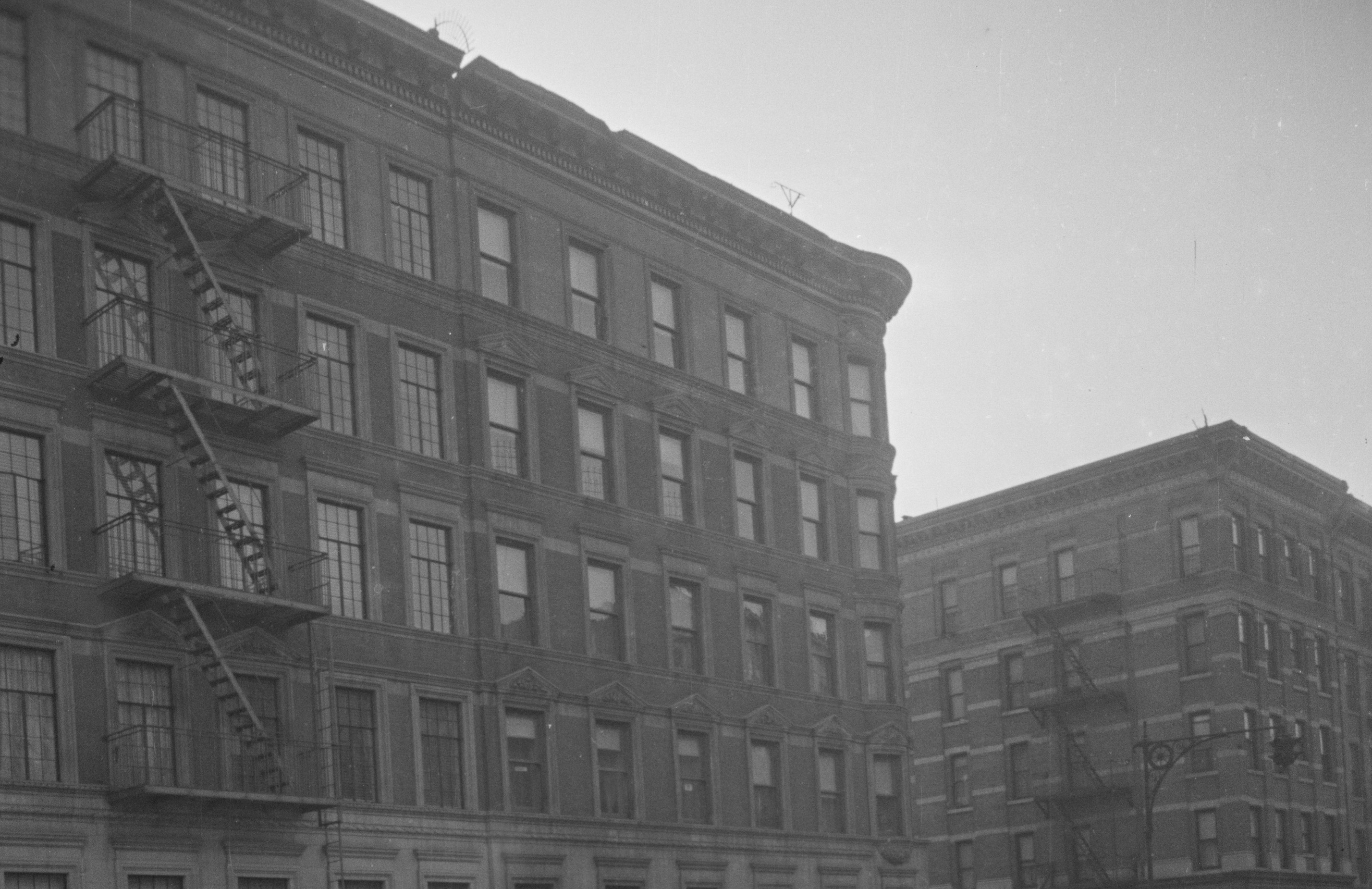
74 Manhattan Ave (19 West 103rd St.)
by Tom Miller
In 1894, developer Robert Dick initiated construction of three apartment buildings that would fill the eastern blockfront of Manhattan Avenue from 103rd to 104th Street. Designed by Martin V. B. Ferdon, the two end buildings, which opened at 19 West 103rd Street and 20 West 104th Street, cost Dick $45,000 each to erect; or about $1.64 million in 2025. (The immense middle structure, at 78 Manhattan Avenue, would cost $84,000.)
Completed in 1895, the three buildings seamlessly flowed architecturally as a single structure. Ferndon’s Renaissance Revival design featured a base faced in limestone; the basement level was surrounded by a light moat. The upper floors were clad in tan Roman brick and trimmed in limestone. The rounded corners of the four top floors created a tower-like effect.
Residents of 19 West 103rd Street entered through a majestic, columned portico atop a dog-legged stoop. They were professional, like musicians Charles S. Virgil and his wife. Mrs. Virgil was the chairman of Musical Clubs and Societies of the Music Teachers’ National Association. Another musical tenant was Wade R. Brown, a pianist, organist, and choral conductor.
All the residents employed one or two servants. Mrs. F. Beyers began looking for a maid and a cook immediately after moving in. On August 15, 1897, she advertised, “Girl to do work for two; must sleep at home.” It appears that the new hire quickly discovered Mrs. Beyers’s fib. On October 1, a more accurate advertisement appeared in the New York Journal and Advertiser: “Girl for general housework, family of three.”
Two weeks later, on March 21, 1905, The Evening World reported she had “recovered the voice she had missed for twenty years.”
A remarkable medical case involved Mabel Penny, who lived here with her mother, Mrs. Banta, in 1905. In 1885, when she was six, Mabel contracted scarlet fever and lost her voice. The New York Herald reported, “Many physicians and throat specialists who were consulted told her [that her] vocal muscles were atrophied, and the girl became reconciled to a life of silence.” Mabel was educated in Brooklyn, where all her lessons were conducted on paper. She learned stenography and, since 1895, had been working in an office.
Early in March 1905, Mabel applied for life insurance. The company sent her to its physician, Richard Ellis, for a physical. Ellis examined her throat, insisted that there was no atrophy, and that the vocal cords “were simply dormant from lack of exercise.” He told her, “Just practice the scales every day and laugh a lot.”
For two weeks, Mabel Penny took walks in Central Park, singing and laughing aloud. Although her first attempts resulted in “inarticulate gurgles,” her progress was rapid. Two weeks later, on March 21, 1905, The Evening World reported she had “recovered the voice she had missed for twenty years.”
Another happy ending played out here that year. Carrie Phillips Ambler shared an apartment with her two elderly sisters. Carrie had been married to H. A. Ambler, but “later obtained a divorce from him,” according to the Middletown Daily Press. When she was a young woman in Monticello, New York, she was the sweetheart of George Olmstead. Like Carrie, he had married. His wife later died. Early in 1905, said the article, “Then he met his first love again.” On December 23, the Middletown Daily Press said, “The wedding at No. 19 West 103rd Street, New York, of Mrs. Carrie Phillips Ambler [and] George Olmstead…culminated an uncommon romance.”
Because the husband of Daisy Ames, who was a traveling salesman, spent long periods on the road in the South, she advertised for a lady’s companion in 1916. Olga Hoffman answered the ad and The Daily Argus said Daisy, “was pleased with the appearance of Miss Hoffman and engaged her immediately.”
A week later, while Daisy was away from the apartment, the 22-year-old companion disappeared along with $150 worth of Daisy’s jewelry. Daisy’s complaint assisted the Manhattan and Yonkers police in following Olga’s trail. In court on July 24, “the pretty and well-dressed young woman, who was the cynosure of all eyes in the crowded court room, pleaded guilty to petit larceny.” The burglary at the Ames apartment ended Olga’s career of what the police called a “’furnished room thief,’ a vocation which she has been following with success for a long time.”
An interesting resident in 1918 was Eileen S. Giles. She was a graduate of the Women’s Medical College of Pennsylvania and worked as an ambulance surgeon.
Katherine Dick sold the building to Edna E Kearns in November 1921. Somewhat surprisingly, in the first years of the Depression, Anne Comerford, a native of Ireland, leased the building and operated it as an Irish boarding house.
On December 30, 1933, The Advocate reported, “Anne Comerford, who boasts of a fashionable boarding house abode at 19 West 103d street, is having a party this week, and all the boys are anticipating a hectic evening! Frank Smith, Mike Harrington, Pat Gorman, Tim Sheehan, Jim Kelly, Jim Meany and Jack Harrington are a few of Nan’s stars!”
A week later, while Daisy was away from the apartment, the 22-year-old companion disappeared along with $150 worth of Daisy’s jewelry.
Patrick Gorman was still living here in May 1934 when he was on the committee to organize a benefit “testimonial and dance…being held for Mrs. Patrick Smith of Belleecks, Co., Armagh” in the Roscommon Ballroom on West 125th Street. Gorman was busy that year, and two months later, on June 21, he and another resident, Frank Smith, managed the six buses that took Manhattanites to Rockaway for the “Maids of Erin” mid-summer ball.
Another Irish-born tenant was Jiki Kelly. On July 7, 1934, The Advocate reported, “the very quiet Jiki (Kilkenny) Kelly of 19 West 103d street (that famous boarding house)” had fallen “for the flaxen-haired Mary Tynan, who is now living at Asbury Park.”
The Advocate announced on September 22, 1934, “Nan Comerford did a ‘Midnight Flitting’—and deserted us—in other words, Nan moved from 19 West 103d street and is now at 128 West 91st Street.” But even under another proprietor, the “boardinghouse” continued to be the home of Irish immigrants. On September 28, 1935, The Advocate reported, “Jeremiah McNamara, 19 West 103d street, will marry Miss Helen Finn of 149 West 73rd street [on] October 27. They are both natives of Co. Cork.” And on October 10 the following year, The Advocate announced, “Timothy Sullivan, 31, of 19 West 103d street, will marry Miss Mary P. Naughton [on] November 22. They are both natives of County Kerry.”
In 1955, the building was converted to a single-room occupancy hotel. Among those living here on December 8, 1976, was 20-year-old Ramon Garcia. That night, he and a cohort tried to rob Claudio Goinez’s grocery store. The would-be crooks did not expect Goinez to resist. In a knife-fight between Garcia and the grocer, Goinez was badly injured, and Garcia was killed.
The building was renovated in 1969. It became the Central Park Hostel, the tagline of which was, “Awesome Sleep on the Cheap!” An advertisement in 2006 offered, “dormitory beds from $26 per night (including tax), brand new studio apartments and private rooms also available.” The Central Park Hotel still operates here, although the room rates are slightly higher. An advertisement in 2008 said, “from $30 nightly.”
Tom Miller is a social historian and blogger at daytoninmanhattan.blogspot.com


